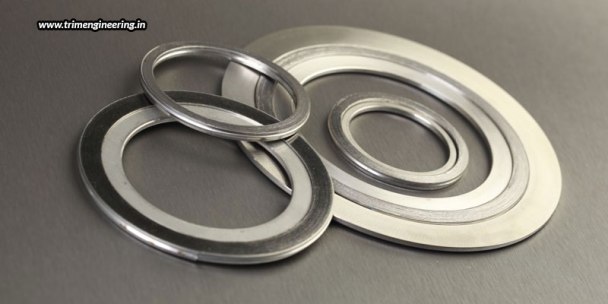What Are The Different Types Of Spiral Wound Gaskets Used?
Spiral wound gaskets are made by spirally winding a metallic material and filler material over an inner ring made of special steel. Generally, the metallic material is wound outwards in a circular spiral, and the filler material is wound in the same manner starting from the opposite side; thus resulting in alternating layers of filler and metal. The metal gives structural support, while the filler material acts as a sealing element. Trim Engineering Services are one of the leading spiral wound gasket manufacturers in India, who not only manufacture spiral wound, but also metallic, and non-metallic gaskets with the best quality materials and processes.
What are spiral wound gaskets made of?
The materials used for the metal and filler are decided upon depending on the chemical compatibility requirements that need to be fulfilled in a particular application. The general materials that are used include –
- Metals like stainless steel, mondel, nickel, inconel, incoloy, and hastalloy
- Filler materials like asbestos, graphite, ceramic, PTFE, and aluminum
- Inner ring materials like stainless steel, carbon steel, titanium, monel, nickel, inconel, incoloy, and hastalloy
Where are spiral wound gaskets used?
Spiral wound gaskets are used under high temperature and pressure conditions – temperatures up to 2000°F, and pressures from vacuum to the standard 2500 psi flange ratings. Moreover, these gaskets are highly resilient and flexible, which help the seal to recover and maintain itself under variable working conditions. These properties have helped in using such gaskets for a variety of applications like valves, pressure vessels, heat exchangers, condensers, pipelines, towers, power generation industries, ships, and man-holes and hand-holes.
What are the different types of spiral wound gaskets available?
There are many different kinds of spiral wound gaskets available, some of the most commonly used ones as below.
Type R – These gaskets have their inner and outer diameters reinforced with only metal without any filler material, thus providing greater stability and better compression. They are used in tongue and groove, male and female, and grooved to flat face flange assemblies.
Type RIR – These gaskets have a solid inner metal ring as a compression stop to fill the annular space between the flange bore and inner diameter. This prevents accumulation of solids, minimizes flange face erosion, and reduces process fluids turbulent flow of process fluids. These gaskets are suitable for male and female pipe flanges.
Type CG – These gaskets have an external ring that centers gaskets on flange face for more radial strength, and acts as a compression stop to prevent gasket blowout. They are used for both flat face and raised face flanges.
Type CGI – These gaskets are CG styled gaskets fitted with an internal ring that provides additional compression limiting stop, while providing a heat and corrosion barrier, thus preventing flange erosion. They are suitable for use in both flat and raised face flanges, where corrosive and toxic media are present.
Type CG-RJ – These gaskets are CG types with an outer ring that covers ring joint grooves and prevents the spiral wound portion from entering the groove. They are used only as a maintenance repair item.
Type HE – These gaskets are spiral wound on the outer portion, and are single or double jacketed for pass bar, fastened to the ID of the spiral wound portion. The HE stands for Heat Exchanger.
Type HE-CG – These gaskets are Heat Exchangers with an outer guide ring and spiral wound primary seal. The outer ring acts as a centering guide and provides adiitonal radial strength to prevent gasket blowout. It acts as a compression stop, and has excellent resiliency and sealing quality.
Type 625 – These gaskets are similar to the basic R-type gaskets with the thickness being 0.0625”. They are used for high pressure sealing in space restricted applications.
Stay social with us on: Facebook, Twitter, Google+, LinkedIn
